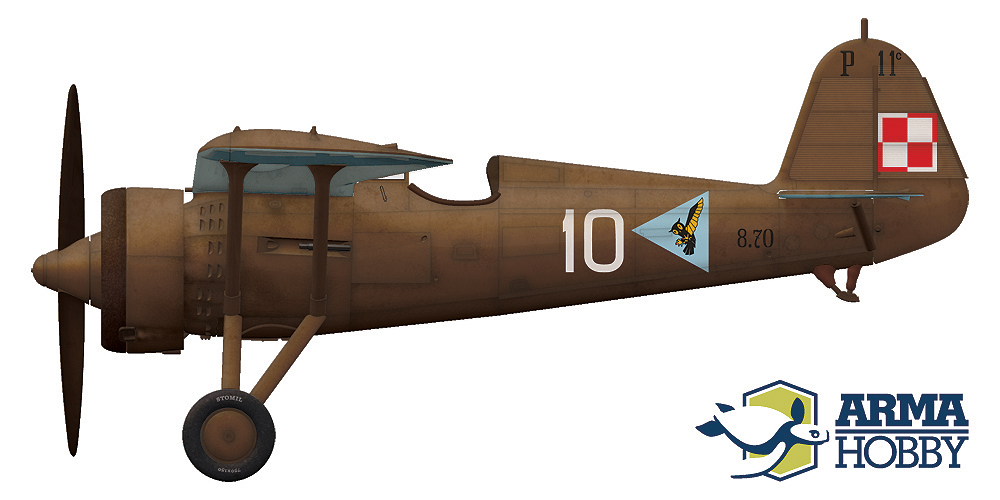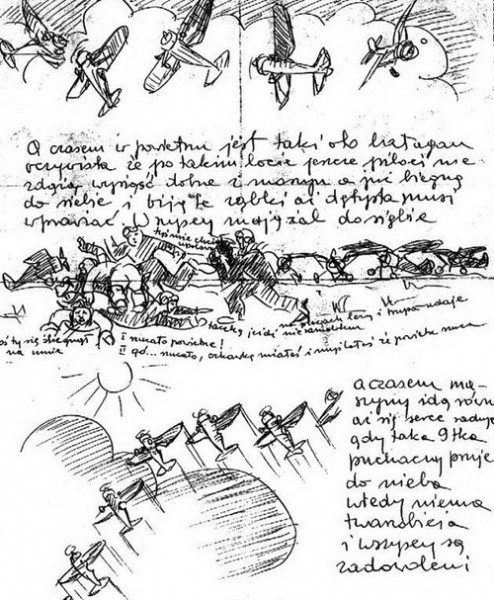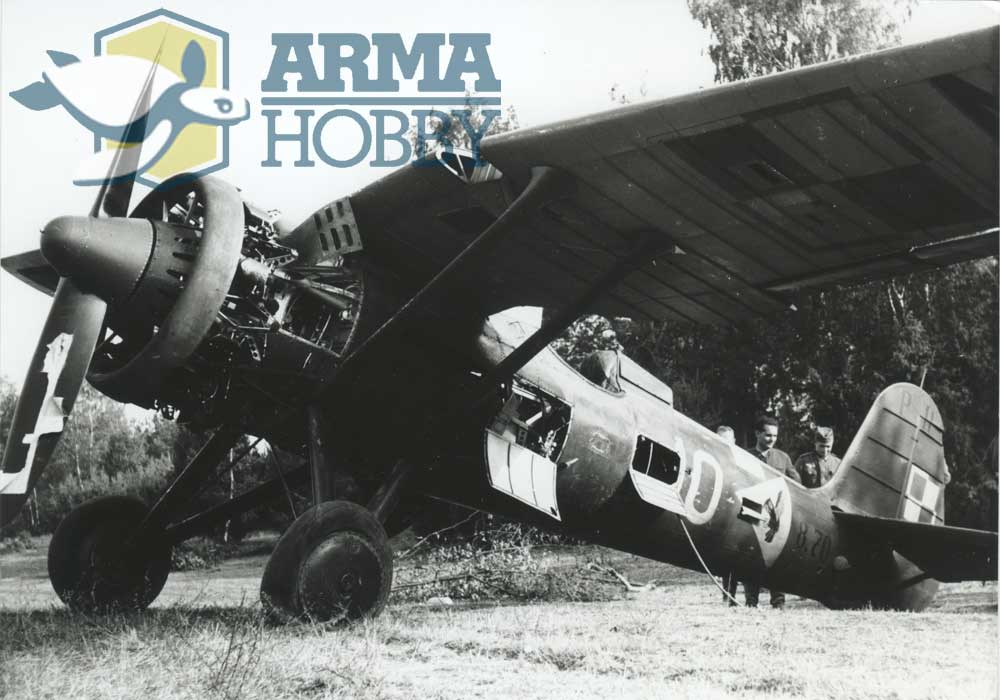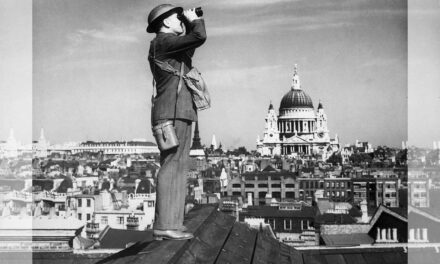– The war started early, about 7 a.m. We have been scrambled, propellers have raised dust from the field, we weren’t able to see anything for a while. We circled in the clouds for a long time, guided by radio orders, so was the beginning…
… told 2nd Lt. Hieronim Dudwał in the interview given in Spring 1940 in Paris to famous poet and journalist Kazimierz Wierzyński. Wierzyński was then collecting accounts of September 1939 Polish soldiers for “Wiadomości Polskie” (“Polish News”), weekly magazine published in London by Polish war emigrants. He met Dudwał, called “Himek” by friends, almost in the last moment. This excellent pilot, one of the most effective fighters of the Brygada Pościgowa (Pursuit Brigade) has died in the air, defending France, soon after that interview.
“Eagle Owls” of Warsaw
Hieronim Dudwał, born in Częstochowa, was a boy-scout and modeller before he joined the army aviation. After completion of training in the Air Force Cadet Officers’ School in Dęblin (with 6th place in group of 47 graduates!) he has been assigned to the elite, Warsaw 113. Eskadra Myśliwska (Fighter Squadron) “Eagle Owls”, based in Warsaw-Okęcie airbase. Before the war, with his unit and other Squadrons of the Warsaw 1st Air Regiment, he participated in numerous excersises and parades which he proudly described in spectacular, carefully illustrated letters to his mother.
Page of Hieronim Dudwał’s letter to mother. Public domain via „Aeroplan” – more: publisher webpage
In 1938 Himek had a half-year long (May-December) intermission in his glamorous life in the Capital City. With six colleagues he has been dispatched to the Polish Wild East aifield in Sarny very close to the border. Their duty was to prevent Soviet reconaissance airplanes from spying the newly-built Polish fortifications.
Himek flew the PZL P.11c serialed “8.70” marked with “Eagle Owl” and white “10”, for some time armed with four machine guns (there is known photo with wing guns and long empty cartridge chute ejectors clearly visible). Later, but already before the war, the wing machine guns have been removed, which improved airplane’s maneuverability.
In the Summer 1939 the Pursuit Brigade pilots performed intensive training in night inteception and cooperation with the searchlight units. The last night excersise took place on the night 23/24 August and it was the last Pursuit Brigade training at all. The airplanes participating in the night flights have been equipped with special lights, visible on the fairing behind pilot’s head on the Dudwał’s airplane photos.
Dudwał’s “white 10” take-off, filmed most probably during the training before 3rd May 1939 parade, can be watched on the preserved period newsreel.
Alarm in the Pursuit Brigade
On 1st September 1939 four Warsaw fighter squadrons, together with the Cracow’s 123. Squadron, were parts of the Pursuit Brigade, which main duty was the defence of the state Capital. 113. “Eagle Owl” and 114. “Swallow” squadrons left their base already on 29th August and flew to the camouflaged, wartime landing ground in Poniatów, North-East of Warsaw. There, in combat readiness, have been waiting for the outbreak of the hostilities. The first warning – a phone call from Suwałki Police – reached the Brigade Command at 5 a.m. The Command have alarmed the Fighter Wings in Poniatów (IV/1 Wing) and in Zielonka (III/1 Wing – with 111. “Kościuszko Squadron” and 112. “Salamander” squadron). The fighters took-off shortly before 7 a.m. The first section of three PZL P.11c has been led by Hieronim Dudwał. Together with him flew Cadet Jerzy Radomski and Senior Airman Mieczysław Kaźmierczak. According to the quoted on the beginning Himek’s account, the sky was cloudy which made the observation and navigation difficult. The pilots were guided from the ground by radio.
– During circling I’ve noticed the Dornier 17 coming out of the cloud. German bomber, the first enemy met eye-to-eye. It looked black, laid like a cross in the turn. […] I had a flash thought: how it is possible? Here? In this air? Over this land?! The thought was gone. What else? Mechanical responses, pure instinct and pure taste of combat. The Dornier was close, well fit in the gun sight. I’ve estimated deflection and sent a burst from the guns. The black cross banked steeply on one wing and glided down. I’ve never seen it again. It dissapeared in the clouds – Dudwał continued the story of his first air-combat in the interview with Wierzyński. The pilot considered this dogfight as unconcluded, and soon met next Germans, which he identified as another Dorniers. But these were three Messerschmitt 110 fighters from 1.(Z)/LG1 squadron. After short skirmish and using all the remaining ammo, thanks to his excellent training and agility of his airplane, Himek managed to break away of the enemy and return to the airfield. – I had four holes in the wing and pierced propeller – he noted.
Hieronim Dudwał manouvers shot position at Heinkel 111, 1 September 1939 afternoon. Artwork by Marcin Górecki.
The last flight of the “white 10”
The damage turned out to be not dangerous and the “white 10”, after refueling and rearming, was fit to the next operation. The order to take-off came about 5 p.m. – against huge group of over 200 enemy airplanes attacking Warsaw. German formation of Luftflotte 1. bombers has been escorted by numerous Messerschmitts 109 and 110. Hieronim Dudwał took off again as a first, and quickly climbed. In his battle account he has described attack against Heinkel He 111, which he claimed as a shot down (German sources do not confirm such loss). Immediately after that Polish pilot started a dogfight against two Messerschmitts Bf 110 from 2.(Z)/LG1 squadron. Initially Himek has identified these planes as Dornier bombers, which could have caused choosing the wrong tactic. The result was a hit by the cannon shell, which demolished the fairing behind pilot’s head, and several other, lesser damages. Dudwał managed to break off the enemy quickly enough and returned to the base. Alas, despite the ground crew’s hard work and resourcefulness, Himek’s faithful “white 10” was never returned to the service. Repaired with sheets of unpainted metal, but not operational, during dislocation of the Squadron to the new airfield, the plane has been left in Poniatów and captured (and many times photographed) by the Germans.
Next days and next fights… till the end
In the following days of the war Hieronim Dudwał flew other airplanes. 4th September he has shot down one German plane, Messerschmitt 110 or Junkers Ju 87 Stuka (various sources give different information). While the exact type can’t be ultimately determined, the fact of the Dudwał’s victory is widely accepted by the historians, including most critical in such cases German researcher Marius Emmerling.
Advertisement
See P.11c model kits in Arma Hobby Internet shop
The final day of the organized fights of the Polish fighter aviation, tragic 17th September, was the day of the Soviet invasion of Poland. For Himek it was also the day of many adventures and a victory. The pilot has been sent with the orders from the Supreme Commander to general Kazimierz Sosnkowski, commander of the Front Południowy (Southern Front or Army Group South), encircled by the Wehrmacht forces near Lwów. During long flight full of adventures Dudwał has found Sosnkowski’s staff near Janów (presently Ivanofrankove, Ukraine) and landed in the field to leave the message. During short talk with the officers on the ground, Himek heard incoming airplane. He immediately run to his PZL and took off, without fastening the seat belts. Surprised German reconaissance Henschel Hs 126 had no chance and after few bursts from Polish guns it crashed near Janów, which is documented with photos of the wreck. It was Dudwał’s second fully confirmed aerial victory. Most probably at that time he flew the PZL P.11c serialed “8.51”, as later that day he used this airplane in evacuation to Romania. For distinguished duty during September 1939 2nd Lt. Hieronim Dudwał was decorated with the Silver Cross Virtuti Militari V. Class.
Himek’s airplane
Hieronim Dudwał’s PZL P.11c “8.70” is one of the best known “elevens”, was many times photographed before and during the war, and even filmed. Reconstruction of it’s painting scheme is not a problem, but it doesn’t mean it is not fascinating!
P.11c piloted by Hieronim Dudwał, photo from Dr Tomasz Kopański collection
Camouflaged in typical khaki/greyish-blue scheme, the plane in 1939 had the top and side surfaces painted most probably with the darker, late variant of the “Polish khaki”, because before the war it has probably been overhauled, which is indicated by the black colour of the serial number and “P.11c” letters on the tail (the factory painted these originally in red). Initially the plane had underwing numbers in white, “70 N” or “170 N”, according to various sources (the three-digit variant is rather doubtful for that period). Later (1939) these numbers have been repainted in black, using the new, three-digit scheme “170 N” (confirmed with photos). Markings typical for the squadron are: white “10” tactical number and the “Eagle Owl” in black and yellow on the light blue triangle.
 The “Eagle Owl” marking of the 113. Fighter Squadron in serious credible publications (eg. Polish Fighter Colours 1939-1947. Stratus Edition) is presented with two clawed hands in yellow, one of them painted over the black abdomen. This is the way we have chosen for the PZL P.11c kit decals, basing on the book profiles and, partially, book and Internet photos of lesser quality. On these photos something visible on the abdomen may be interpreted as three claws. However, already after finishing of the decal printing process, we have got the high quality photos proving that the owl’s abdomen is uniformly black, and the shapes interpreted as claws are simply heads of the rivets! As a result, the modeller, wanting to have a proper “Eagle Owl” marking will have to carefully overpaint the claws on the bird’s belly with the black paint.
The “Eagle Owl” marking of the 113. Fighter Squadron in serious credible publications (eg. Polish Fighter Colours 1939-1947. Stratus Edition) is presented with two clawed hands in yellow, one of them painted over the black abdomen. This is the way we have chosen for the PZL P.11c kit decals, basing on the book profiles and, partially, book and Internet photos of lesser quality. On these photos something visible on the abdomen may be interpreted as three claws. However, already after finishing of the decal printing process, we have got the high quality photos proving that the owl’s abdomen is uniformly black, and the shapes interpreted as claws are simply heads of the rivets! As a result, the modeller, wanting to have a proper “Eagle Owl” marking will have to carefully overpaint the claws on the bird’s belly with the black paint.
Additional markings painted on the airplane are the blue stripes on the right side of the tail and on the right wing. These could be the markings of the Squadron special duty officer (flight leader?) or markings used to aid proper formation forming during the parade. On some airplanes with similar markings the third feature is present – one wheel boss is painted with the same colour as the stripes, on the same side. In case of Dudwał’s airplane we have no confirmation of the painted wheel, the only known photo shows the right wheel in deep shadow which does not allow to determine its colour.
The national markings – the checkerboards on the wing top surface were in 1939 partially scraped.
 Hieronim Dudwał markings you can find in PZL P.11c Expert Set model kit
Hieronim Dudwał markings you can find in PZL P.11c Expert Set model kit
- Plastic parts
- Photoetched parts
- windscreen and wheels masks
- Cartograf decals with four markings variants
Recommended readings:
- Łukasz Łydżba. IV/1 Dywizjon Myśliwski. Wyd. Vesper, Czerwonak 2013
- Polish Fighter Colours 1939-1947. Praca zbiorowa. Wyd. Stratus, Sandomierz 2016
- Jerzy B. Cynk. Polskie lotnictwo myśliwskie w boju wrześniowym. AJ-Press, Gdańsk 2000
- Marius Emmerling. Polskie zwycięstwa powietrzne w 1939 r. […] Część 1. Dywizjony Brygady Pościgowej III/1 i IV/1 oraz eskadry szkolne. „Technika Wojskowa Historia. Numer Specjalny 4/2016 Warszawa 2016
Photos of the Hieronim Dudwał’s PZL P.11c after capture by German troops
Selection of photos from Dr Tomasz Kopański colection. Dudwał’s aeroplane with visible fuselage back repairs with metal sheet – was abandoned on airfield. It draw a great attention from German troops and was extensively photographed:
Modeller, son and father of a modeller. Loves digging through references and analysing old photographs. He builds aircraft, ship and vehicle models, the older the better. He has a weakness for Polish equipment, but does not despise the RAF, FAA and Great War topics. A journalist by training.
This post is also available in:
 polski
polski
















